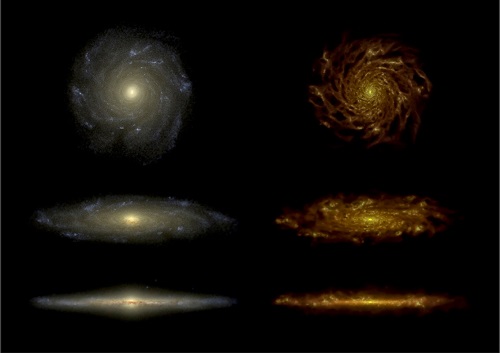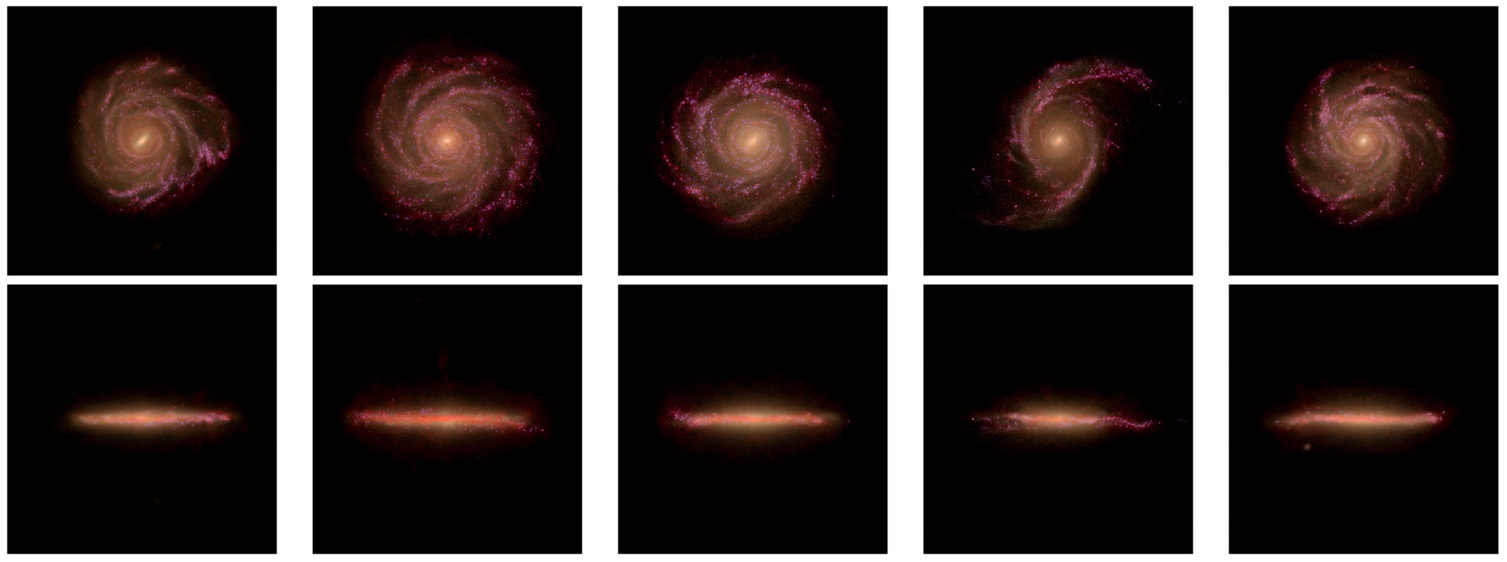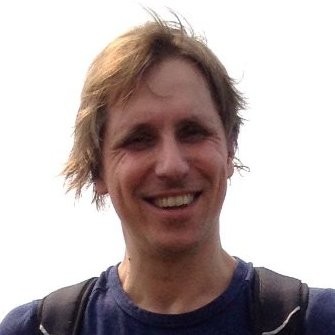User story : Mocking the universe

Galaxies are widely considered the basic building blocks of our Universe. Therefore, it is crucial to understand them to gain insight into the Universe. Cosmological hydrodynamic simulations are an increasingly popular method to study galaxy formation and evolution. In this user story Maarten Baes, prof. astrophysics at Ghent University explains how supercomputing is essential for their cosmological simulations.
Understanding galaxies
Astronomy tries to find scientific answers to questions like ‘where do come from: how did the universe originate?’ and ‘how has the universe evolved up till now and how will it evolve in the future?’. The universe has billions of galaxies of which the Milky Way is only one. To better understand our Universe, we need to study how its building blocks are formed and evolve.
A galaxy consists of stars, stellar remnants, interstellar gas, dust, and dark matter, all held together by gravity. But besides gravity, there are numerous other complex processes at work in galaxies at vastly different scales. To study galaxies, observations and computer simulations are used. However, comparing synthetic data (resulting from simulations) and observed data is like comparing oranges to apples. Indeed, observations are the perception of light and simulations involve particles in a 3D space. To match the two, the output of the simulations needs to be converted into one that can be compared to observations.
SKIRT
This is where the expertise of the team of Maarten Baes at Ghent University comes in. They convert computer simulations into images. They strive to do this as faithfully as possible, because there again, other physical processes come into play (different sources radiating, light being hindered, absorbed, scattered, converted into infrared radiation, etc....). By taking all those aspects into account they try to make simulated images as true to nature as possible so that a comparison with observation can be made.
SKIRT, the multi-purpose 3D Monte Carlo code developed by prof. Baes and his team simulate radiation transfer in a wide variety of dusty astrophysical objects. It emulates the relevant physical processes that determine how instruments of astrophysical systems, particularly the interstellar medium's scattering, absorption, and thermal emission. The code features a wealth of built-in geometries, radiation sources, dust characterizations, spatial grids, and detectors.
SKIRT is particularly tailored towards generating synthetic observations of cosmological hydrodynamics simulations using supercomputing. The code supports efficient hybrid parallelization with an arbitrary mix of multiple processes (possibly distributed over multiple compute nodes) and multiple execution threads per process.
Use of supercomputing
Why is supercomputing essential in this process? The generation of synthetic multi-wavelength observations for cosmological simulations is an extremely computationally demanding job that requires the use of supercomputing facilities. For example, in Camps et al. (2018) prof. Baes and his coworkers presented synthetic UV – submm fluxes for nearly half a million simulated galaxies from the suite of EAGLE simulations. The total run time was equivalent to 630 years of serial processing.
The SKIRT code has become one of the most widely used dust radiative transfer codes in the community. The specific application of SKIRT to generate synthetic observations for cosmological hydrodynamics simulations has proven particularly successful. Most state-of-the-art cosmological hydrodynamics simulations (EAGLE, IllustrisTNG, FIRE-2, Auriga, ARTEMIS, ...) are using SKIRT-generated synthetic data for their comparison to the observed Universe.
The SKIRT-generated synthetic data are also being used to help predict the capabilities of planned ground- and space-based observatories, informing the design of these facilities or new satellites.
For example, the team of prof. Baes is also involved in the Euclid mission of the ESA (European Space Agency). Euclid is designed to explore the evolution of the dark Universe. It will make a 3D map of the Universe (with time as the third dimension) by observing billions of galaxies out to 10 billion light-years, across more than a third of the sky. The Euclid spacecraft comprises a 1.2 m-diameter telescope and two scientific instruments: a visible-wavelength camera and a near-infrared camera/spectrometer [1]. By using SKIRT the team can run simulations to make the right choices to optimize the scientific programme of the mission (e.g., when using a camera with sensitivity rate X in wavelength area Y it might be better to expose a bit longer and have a smaller field of view or which data is needed to get the scientific information one wants to obtain).
As already mentioned, SKIRT is used by most state-of-the-art cosmological hydrodynamics simulations to generate synthetic observations. This leads to close interaction between the UGent SKIRT team and the most advanced simulation teams in the world resulting in active involvement in ongoing and future numerical experiments and telescope projects.
Hackaton
A few years ago, prof. Baes and his team gained new insights into their field via a hackathon. This event was organized by Gert De Geyter, former PhD student of Maarten Baes at Ghent University and now Machine Learning Lead at Deloitte in New York.
The idea was quite simple: galaxies have different shapes and their colour is related to their shape. For example, the ones that have lots of spiral arms are typically bluer and the ones that have less structure (elliptical galaxies) are typically redder (because physically different kinds of star populations are present). Thus the colour is often used to estimate mass. However, if there is only a picture available at one wavelength, there is no data about the colour.
The question for the hackathon was: “instead of using colour, can we look at the structure of a galaxy and say something about the morphology?”.
Prof. Maarten Baes: “I was not familiar with the idea of a hackathon but it was very cool. All the people who took part were enthusiastic and knew nothing about galaxies but were interested in the challenge itself. The team Andromeda42, consisting of Serge Krier, Stephane Pirson, and Calin Rares Turliuc, won the hackathon and their output was presented in a scientific paper [2]. ”
During the hackathon, the participants were allowed to use the VSC infrastructure and VSC staff was also present to support them.
Relevant links
The SKIRT code: https://skirt.ugent.be
Below is a selection of scientific papers using SKIRT applied to cosmological hydrodynamics simulations:
- Camps et al. 2016, Monthly Notices of the Royal Astronomical Society, 462, 1057: Far-infrared and dust properties of present-day galaxies in the EAGLE simulations
- Trayford et al. 2017, Monthly Notices of the Royal Astronomical Society, 470, 771: Optical colours and spectral indices of z=0.1 EAGLE galaxies with the 3D dust radiative transfer code SKIRT
- Camps et al. 2018, The Astrophysical Journal Supplement Series, 234, 20: Data release of UV to submm broadband fluxes for simulated galaxies from the EAGLE project
- Baes et al. 2020, Monthly Notices of the Royal Astronomical Society, 494, 2912: Infrared luminosity functions and dust mass functions in the EAGLE simulation
- Kapoor et al. 2021, Monthly Notices of the Royal Astronomical Society, 506, 5703: High-resolution synthetic UV–submm images for simulated Milky Way-type galaxies from the Auriga project
- Vandenbroucke et al. 2021, Astronomy & Astrophysics, 653, A34: Polarised emission from aligned dust grains in nearby galaxies: Predictions from the Auriga simulations
- Trcka et al. 2022, Monthly Notices of the Royal Astronomical Society, to be submitted: UV to submillimetre luminosity functions of TNG50 galaxies
Please note the above is a list of several relevant publications from prof. Baes and his team, while many other astronomers have used SKIRT for similar purposes. For a more complete overview, please check https://skirt.ugent.be/root/_publications_gallery.html
Illustration 1: Simulated images of a galaxy by SKIRT
On the left side, images are shown as we would see them in the visible part of the spectrum.
On the right side, the same galaxy is shown but now simulated at a wavelength we cannot see with the naked eye (infrared). This shows the thermal emission of dust and thermal radiation. This can only be seen with space satellites.
In 2009, a large ESA satellite was launched that was operational in that wavelength region and now we can compare these simulated images with the images observed in the far infrared.

Illustration 2: Simulated images of several galaxies by SKIRT:
Image of 5 galaxies (part of a much larger collection of hundreds of simulated galaxies). The top is a frontal view and the bottom is a side view. In these simulated images false colours are used and combined: yellowish for the visible light and the red on top is the infrared radiation. These are all galaxies simulated in such a way that they should approximate the properties of our own Milky Way.

[1] Source: Website The European Space Agency (2022) https://www.esa.int/Science_Exploration/Space_Science/Euclid_overview
[2] Link to paper: A&A, 18/04/2019, https://www.aanda.org/articles/aa/abs/2019/04/aa34575-18/aa34575-18.html

Maarten Baes is a professor of astrophysics at Ghent University. His research interests include interstellar dust, radiative transfer, infrared astronomy, galaxy evolution, galaxy dynamics, and supermassive black holes. He is engaged in both theoretical and observational astronomical research, and he is involved in several instrumentation projects, both for ground-based telescopes and space missions.
Peter Camps is a senior postdoctoral researcher in the team of prof. Baes. His research interests include radiative transfer, interstellar dust, galaxy evolution, and software design. Over the past decade he has been the main SKIRT developer. He applied the code to several cosmological simulations and assisted users inside and outside of the UGent team to produce synthetic observations.